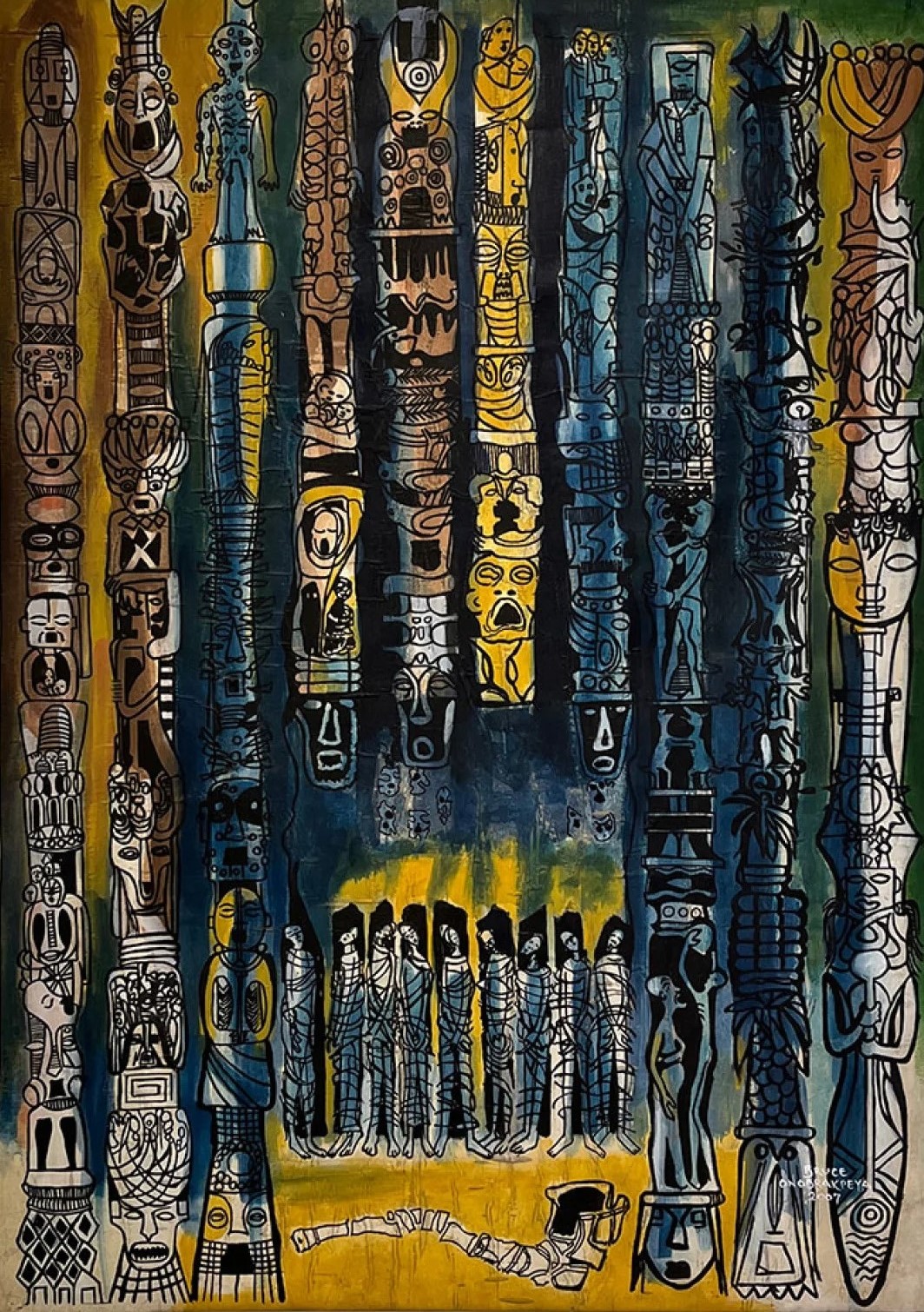Shrines and Shrine Masters: D.O. Ebengho and Bruce Onobrakpeya: Brief Comparative Photo Essay and Research Funding Quest Part 6: Onobrakpeya on the Ogoni Nine
Oluwatoyin Adepoju

A brief comparative study of two masters of shrine art, D.O. Ebengho and Bruce Onobrakpeya, in the context of a funding quest to support novel studies of both artists.
The pictures of Ebengho's art were taken by myself in early November 2022. The sources for images of Onobrakpeya's work are indicated in the essay.
Here are parts 1, 2 , 3, 4 and 5 of this essay.
Discursive Gaps
Cosmological Vision between Ifa Hermeneutics and Ebengho's Shrine Construction

History and mystery converge in Onobrakpeya's Martyrdom of
the Ogoni Nine, commemorating the execution, by the dictatorial Sani
Abacha Nigerian government, of Ken Saro Wiwa and fellow environmental rights
activists in Ogoniland.
The nine figures tied up at the stake are visible in the lower foreground but
around them is a configuration of forms, almost phantasmagoric in their
structurations and variety, their vertical elevation seeming to evoke a
congregation of spirits embodying the reverberations of the agonies
dramatised by the twisted forms of the condemned men, like the
upward thrust of a cathedral spire suggests the aspiration of devotees seeking
to pierce into the spiritual universe the place of worship represents,
only, in this instance, the artist might be visualizing the psychological,
social and historic reverberations of this incident, savaging collective
consciousness in Ogoniland, in the South-South to which the region belongs and
in Nigeria as a whole, as human blood is used to pay for
peoples' inability to address issues fundamentally rather
than through such stop-gap measures as the execution of the activists,
an execution triggered by a number of killings attributed to
them, a cycle of death and destruction that the Niger Delta has suffered from
on account of rapacious approaches to oil exploration
in Nigeria's economic centre of public resources.
Screams seem to emanate from mouths opened in contorted faces,
resonating across the entire space, as other figures of calm watchfulness
seem to absorb the vibrations of agony reverberating across the landscape, as a
woman tenderly holds a child in her arms next to a soldier with a downward
facing gun, echoes of the complex of humanity, of creativity and destruction,
of sadness and hope, shaping the history of the Niger Delta, particularly its
struggle with the ''resource curse'', the negative correlation between communal
well being and natural resources that has plagued a good number of struggling
nations.
The totemic character of the stylized verticalisations of this painting animates a good number of Onobrakeya's work in two dimensions, as the spatial surface of the canvas is used to suggest realities even beyond three dimensions, the ordered multiplicity of figures ascending on top of each seemingly into infinity, as the demonstration of their variety in the artist's ingenuity seems infinitely replicable, new forms emerging with each iteration, as the figures seem to crowd their way out of the two dimensional space into an enlargement of the framework within which they are constructed, becoming almost larger than life even though visualised in almost miniscule forms.
This aesthetic suggests Onobrakpeya's assimilation of the use of vertical poles in Southern Nigerian and particularly Benin shrine aesthetics in suggesting a sense of expansive space through the spatial amplitude created by long staffs leaning against a wall, the arcane carving of these staffs and the esoteric visage of the other elements of the shrine, in combination perhaps, with inexplicable atmospheres generated in the shrines through years of ritual, of concentrated attention in seeking to use them as matrices of convergence of matter and spirit, actualizing a sense of something uncanny, a space alive with presences unseen but brushing against the outer edges of consciousness, atmospheres different from those of other spaces outside that zone, Onobrakpeya seeking to project that sense of multiple existences, sensed but invisible, the shrine space opens into.
Image from kpbs.com
